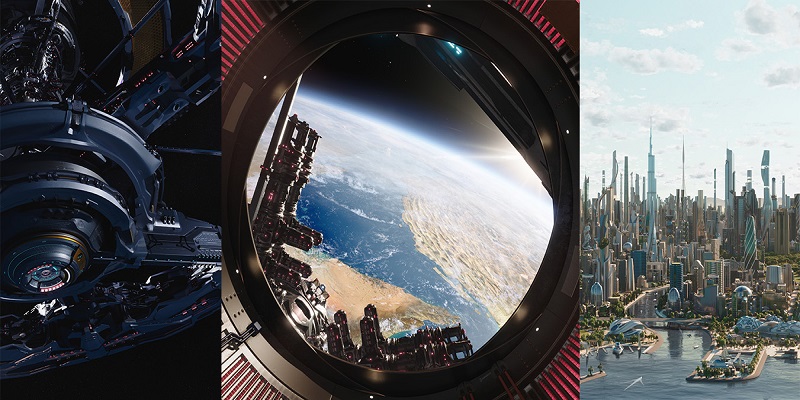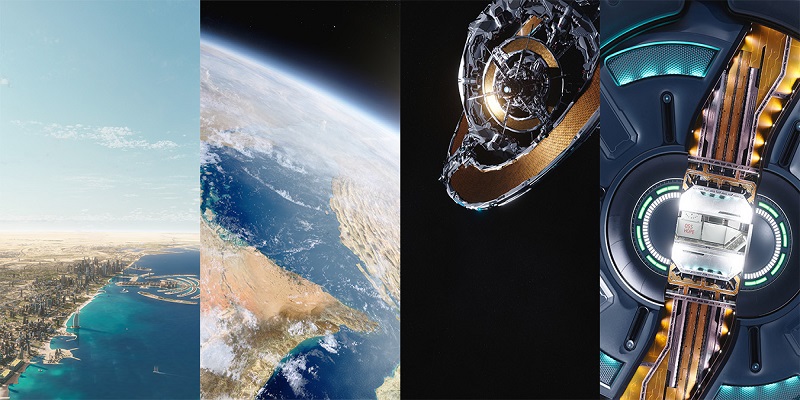Something novel, set in in the year 2071, The Museum of the Future in Dubai tells the story of life, nature and spirituality of the future. Framestore was asked to create the moment guests are transported into the future via a rocket launch from the future city of Dubai, up into space and finally docking into the spectacular space station OSS Hope.
This first of a kind immersive institution is designed to inspire us all to help shape a better world for our future.
“Working with Framestore was a pleasure and an inspiration. Together we crafted one of the museum’s most important and appreciated works, an experience that kicks off the visitor journey with excitement and elegance,” said creative director Brendan McGetrick.
Framestore creative director, Jason Fox headed up the monumental project alongside VFX Supervisor, Jay Khan. For the project they created a fully CG city of Dubai and designed the full sequence from ground to orbit including the return sequence as well as the space capsule.
“We started with the art department, designing the physical space capsule itself. This, in reality, is a huge freight elevator that transports guests to the top of the museum to start their adventure. We wanted to lean into the familiar tropes of space vehicle design but with the added layer of something more commercial and accessible. Our design is based on symmetry, on all axis, so the walls, floor and ceiling mirror each other giving the architecture a sense of zero gravity,” said Fox.
Where the launch is magnificent and awe inspiring as you float in zero gravity into the arms of a space station, the return is a white-knuckle express drop straight back home, designed to bring guests back to earth, with a bump or two.
“The return capsule was designed to be smaller with one huge screen on the floor. The guests grip handrails as the floor beneath them opens up to reveal earth below their feet. Shooting them out into space they go through reentry before landing in a tornado of dust and noise back at the Dubai SpacePort,” Fox mentioned.
Collaborating once again with the sound studio Grand Central Recording Studios (GCRS), the team created an immersive 360-degree soundscape. From the bone shaking rockets of the launch, to the sublime musical approach to OSS Hope, the sound and the visuals make for an unforgettable experience. Raja Sehgal, the sound designer at GCRS, was involved early on in the creation of the lift and recommended where within the space the speakers should be integrated. GCRS’ Studio 8 in London was redesigned to emulate the dimensions of the experience and create cinematic sound. Raja then spent time on site in Dubai interfacing the system into the live experience.
Building the whole of Dubai 50 years in the future was a huge undertaking which involved rendering over a trillion pixels and a heavily procedural workflow.
“Creating the vast city of Future Dubai was a monumental task. From a design perspective it had to feel like Dubai but wrapped with a futuristic narrative. From a production standpoint it had to feel real from the shoreline at ground level to beyond the horizon viewed from the edge of space,” the creative director said.
Fox further mentioned, “We wanted to ensure there were no bad seats in the house, so we made sure each of the 10 giant 75inch 4K screens had a story to tell. You can stand by one to see the shoreline extend down off towards Abu Dhabi. Or watch the Burj Khalifa surrounded by new green lands, hyperloops and fantastic new architecture throughout the sprawling city.”
The project was so big that when they came to finalise it, the team needed the full render capacity of the studio for four weeks leaving them with only one opportunity to do it.
“The amount of pixels that we had to render was vast, 1.2 trillion or four feature films worth, which meant we only had one chance so we tested, tested and tested again before hitting render – it was nerve wracking because there were no second chances,” said Jay Khan.
There is a bioengineering flavour to the architectural design with futuristic buildings that are dripping with solar panels or have a whole forest halfway up the side. The clients provided them with information of what planning permission was underway, which they took as inspiration.
“We ended up designing and building over 400 buildings. We quickly realised that that wouldn’t be enough, so we added extra detail using trees, solar panels, wind turbines etc, and because building that in CG and laying it out by hand would take far too long, we came up with a procedural workflow,” said Khan.
Using Houdini, Framestore’s VFX team could build iterations from a few hundred instanced buildings rather than thousands, making it more efficient to render such a large number of assets. They also grabbed open source data from Open Street Maps which they pulled into Houdini, giving them a map of Dubai including where land masses and rivers currently are. This helped drive their layout and get positions of all the key landmarks from the city which they fleshed out with their procedural buildings, trees, parks and roads. Although they had to be true to Dubai, they could add their own architecture.
“I like to find procedural or efficient ways of building things, and this was that on a huge scale – it was a tricky task balancing the many factors that go into building a city. Jason had some great concepts about how the city could look in the future, making sure we could incorporate these ideas and still have a cohesive functioning city was a technical challenge. I’m very proud of the whole team for creating such a stunning view of Dubai,” said Khan.
The project included working with their artists to achieve beautiful depictions of Earth from space and the city.
“We rendered the Earth using an extremely large texture, up to 80K but even that wasn’t high enough resolution wise for our views of the planet. So, we created digital matte paintings for key frames giving us all the detail we required and kept adding incremental digital matte paintings until it all stitched together nicely for one perfect map,” Khan said.
The team based the shuttle trajectory on real world physics including having everything on a real world scale. The height of where it docks was based on the height of the International Space Station but to achieve this the team had to cut out bits in between.
“We started off with the trajectory of a real space shuttle, but we had to squeeze what was technically a twenty minute journey into three minutes. We wanted the take off to be in real time so visitors can take in everything around them. When you are traveling through clouds and the atmosphere however, it becomes a lot calmer so we could speed that up a little bit. Then as we approached the space station for docking, we slowed it back down again so the viewers could marvel at the scale of OSS Hope,” Khan shared.
The docking procedure holds a tremendous amount of detail in terms of animation, lighting and sound design.
“It feels truly epic on Kubrick level, I’m immensely proud of what Jay and his team created. The complexity and detail we put into animation staging of the gigantic docking procedure pay off so well, you feel like OSS Hope is wrapping her arms around in a giant hug as we float into the bright lights of the docking bay,” Fox revealed.
The team built an in-house mock up space where they could emulate the capsule using large TV panels mounted to the same scale as the elevator in Dubai. This let the team feel the movement of the media and ensure the install would be seamless.
“The screens gave us a great representation of the perspective shift as you walk around the lift and the consistency of the horizon line which enabled us to quickly ascertain whether any of the sensations were off, including whether any of the rising and tilting would make the visitors feel nauseous,” said Khan.
“You could ride the lift twenty times and see something different depending on which window you are looking out of,” added Jason Fox.


